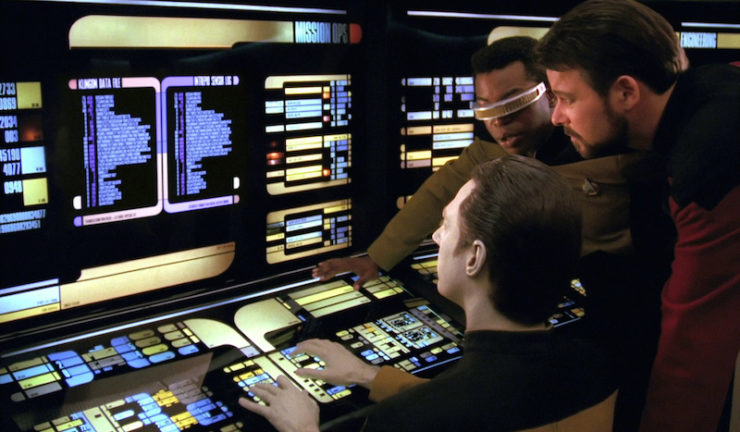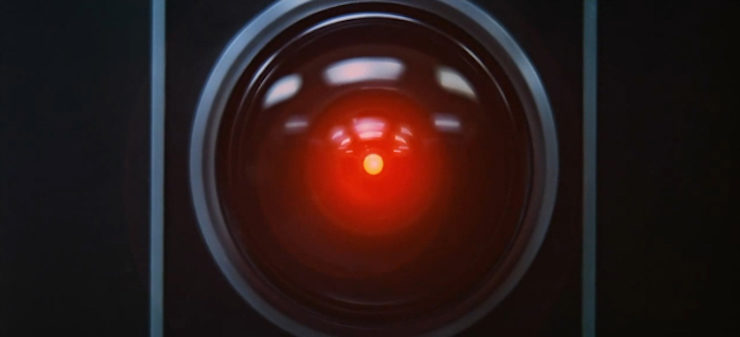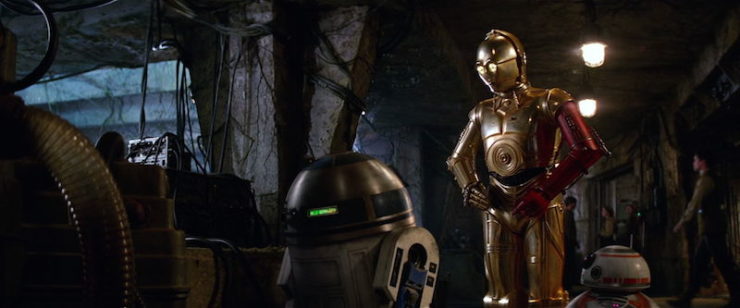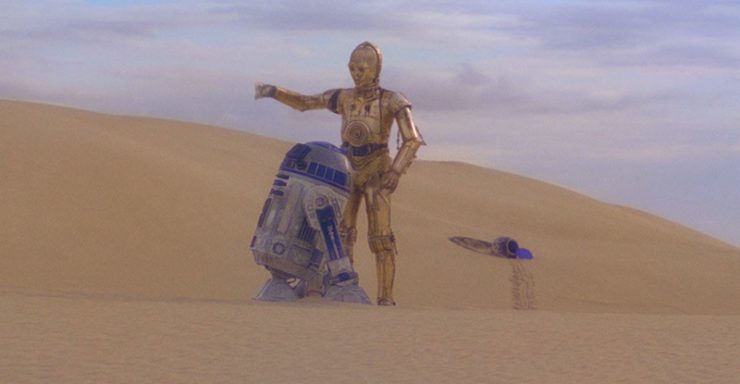Technology-based lifeforms have to communicate, just like any other living beings. And just like living beings, science fiction has come up with a variety of ways for them to do so. Keeping tabs on the way robots, computers, and A.I. convey information in genre fiction offers an fascinating glimpse into what humans think the future might look like—and how we would prefer to interact with technology ourselves.
When looking to science fiction for sentient life created by artificial means, there are plenty of possibilities to choose from. A.I. and robotics are some of the oldest hallmarks of the genre, and there are countless ways to render characters that fit the bill. But with those characters come a number of questions about how they move through the world (/galaxy/universe) and who they interact with. Were they created for a specific purpose, or to exist as they will? Do they have a community of their own kind, or are they restricted to humans and aliens and other organic matter? And if they do have their own communities… doesn’t it stand to reason that they would have their own traditions, their own philosophies, and even their own forms of communication? And what do those forms look like?
A lot of it, unsurprisingly, comes down to functionality.

Artificial intelligence that looks and behaves in a human manner is hardly a surprising concept, and there are plenty of well-loved characters in sci-fi who fall into this particular niche. Star Trek’s Data communicates like your average human being, even engaging with the Enterprise much in the way that his shipmates do—he sits at a station, he uses a tactile interface. Data does have certain abilities that allow him to bypass this manner of interface, but he often prefers to behave as a human would; he interacts in this matter because his creator—Noonian Soong—designed Data to that specific purpose. By and large, Data continues on as his creator intended, and spends most of his time connecting the way a human would. The major differences for him on this account are his inability to pick up every human cue through speech and body language, but that’s to be expected for any being with a lack of experience.
What’s notable about this is that Data doesn’t have many peers, but when he does encounter other artificial intelligence (such as his predecessor, Lore), he still makes the choice to communicate in a human manner. There is no “robot communication” that they engage in, no special language that humans aren’t privy to among their own kind. And this is an interesting decision because it makes humanity’s own anxieties about the Singularity all too clear—an anxiety only stoked the closer we get to true sentient artificial intelligence. Watson may talk to other humans in plucky commercials, but Facebook was recently running a couple A.I. that began creating their own language… and promptly had to pull their plugs because humans couldn’t understand what they were saying.

Indeed, the way that fiction tends to portray robots and A.I. has a great deal to do with our own personal comfort in that ability to converse, and whether the characters in question should be frightening or relatable to us. In 2001, HAL 9000 deliberately communicates in a manner that is civil and friendly, even while slowly murdering the crew of the Discovery One. HAL’s ability to seem benign and even chipper as he commits horrendous acts is part of what makes him terrifying. The same is true of Portal’s GLaDOS, though with her mastery of human language, GLaDOS is fully aware of how to insult someone while maintaining a seemingly helpful facade; she spends the game essentially “negging” the central character Chel.
Both HAL and GLaDOS essentially operate as individuals, but what about interconnected A.I. networks? The Matrix framework contains a multitude of consciousnesses, both human and A.I. Though programs (like the Agents) can use the construct of the Matrix as a means of communicating with the humans connected to it, it is unknown if there are other ways that artificial beings within the Matrix have the ability to connect with and contact one another. There are hints, suggestions that the code of the Matrix itself gives them clues about where others are, but we are never privy to those interactions, making the Matrix a far more dangerous place. Skynet from the Terminator series has the distinction of being a sort of group artificial consciousness, but we are similarly shut out of how that hive communicates, or even how a group consciousness could be said to function in that aspect.

Annalee Newitz’s upcoming novel Autonomous has a fascinating construct in place to indicate the difference in robot-to-robot communication. Whenever two robots come into contact, they engage in an introduction that works as a sort of alternative to the human handshake. Here is a sample of one such greeting:
The mantis beamed Paladin a hail. Hello. Let’s establish a secure session using the AF protocol.
Hello. I can use AF version 7.6, Paladin replied.
Let’s do it. I’m Fang. We’ll call this session 4788923. Here are my identification credentials. Here comes my data. Join us at 2000.
This opening clearly has multiple purposes, and serves robotic needs rather than organic ones; the robots indicate what sort of software they are using to contact one another, labeling their conversation so that it has a place in their memory, and offering credentials to ensure authenticity. Humans have their own ways of doing the same, using our senses to get a better “read” of a person and what thy might be comfortable with and require in a one-on-one situation. While the robots in Autonomous have a new script, they are asking for similar cues, highlighting the dividing and unifying lines between people and A.I. in one swoop.

Farscape offers an adjacent possible route in mechanized interaction through the Leviathan species—ships that are biomechanoid, incapable of existing without their biological or their technological components. These ships are thought of as organic beings overall, but it is never made clear where their sentience originated. The entire show took place primarily on Moya, a Leviathan ship who plays host to a mismatched crew of criminals. But Leviathans have no way of communicating with their passengers directly; instead, Moya has a Pilot who has the ability to communicate with her, and can convey her thoughts and feelings to her crew. Moya also has the ability to communicate with repair drones known as DRDs–though their manner of communication is also never explained in any detail–and the ability to communicate with other Leviathan ships, but Pilot’s ability to communicate on her behalf was singular.
The idea of having an interpreter for a form of artificial intelligence is also the common arrangement for two of pop culture’s most beloved robots: C-3PO and R2-D2. Indeed, the Star Wars universe has a multitude of technological sentience that communicates in a variety of ways—though this often goes ignored by the organic life in their universe. Both Threepio and Artoo display sentience, but Threepio communicates in a human manner because his function as a protocol droid calls for his ability to communicate with multiple species. As an astromech droid, Artoo was primarily created to repair and maintain ships and other mechanical systems, so he speaks in a manner that is more useful among machines. This suits his function, but it means that when Artoo wants to converse precisely with organic lifeforms, he requires some form of interpretation. Humans do sometimes guess what the astro droid is saying, but nothing is as precise as an on-screen translation… or Threepio’s more colorful explanations.

The Star Wars universe also appears to have computers with a certain amount of sentience as well, which humans interestingly cannot communicate with if they don’t have a droid handy. In Empire Strikes Back, Han Solo tells Threepio to “talk to the Falcon” to find out what’s wrong with the hyperdrive, and Threepio makes mention of the Falcon’s computer having a “peculiar dialect.” The protocol droid scolds Artoo for trusting “a strange computer” on Cloud City. In Claudia Gray’s Bloodline, Threepio has a hard time getting the information he needs from a computer in a timely manner because the computer has been “lonely” and wants someone to talk to. So there are levels to Star Wars A.I. communication that go unremarked upon by the universe’s organic lifeforms, and they offer a strange depth to that galaxy’s dependence on technology.
The ways in which artificial intelligence and robots communicate with one another perhaps tells us more about humanity than it does about the emergence of A.I. … but it still conveys a great deal about where we might go as we continue to develop more advanced technology. After all, while they may develop languages of their own, robots and their ilk will still be shaped by the humans who create them, in accordance with what those humans believe they want from A.I. It’s only a matter of time before we see how many of these stories ring true.
Emmet Asher-Perrin is waiting to have robot friends. Still. You can bug her on Twitter and Tumblr, and read more of her work here and elsewhere.










